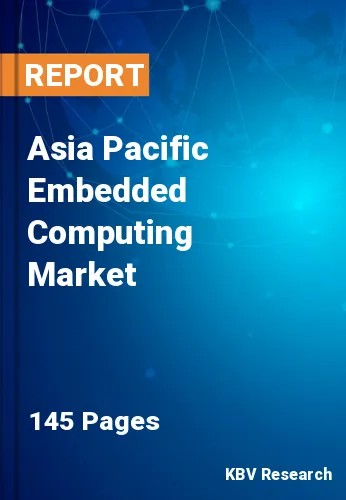Chapter 1. Market Scope & Methodology
1.1 Market Definition
1.2 Objectives
1.3 Market Scope
1.4 Segmentation
1.4.1 Asia Pacific Embedded Computing Market, by Component
1.4.2 Asia Pacific Embedded Computing Market, by End User
1.4.3 Asia Pacific Embedded Computing Market, by Country
1.5 Methodology for the research
Chapter 2. Market at a Glance
2.1 Key Highlights
Chapter 3. Market Overview
3.1 Introduction
3.1.1 Overview
3.1.1.1 Market Composition and Scenario
3.2 Key Factors Impacting the Market
3.2.1 Market Drivers
3.2.2 Market Restraints
3.2.3 Market Opportunities
3.2.4 Market Challenges
Chapter 4. Competition Analysis - Global
4.1 KBV Cardinal Matrix
4.2 Recent Industry Wide Strategic Developments
4.2.1 Partnerships, Collaborations and Agreements
4.2.2 Product Launches and Product Expansions
4.2.3 Acquisition and Mergers
4.3 Market Share Analysis, 2023
4.4 Top Winning Strategies
4.4.1 Key Leading Strategies: Percentage Distribution (2020-2024)
4.4.2 Key Strategic Move: (Partnerships, Collaborations & Agreements: 2020, May – 2024, Nov) Leading Players
4.5 Porter Five Forces Analysis
Chapter 5. Asia Pacific Embedded Computing Market by Component
5.1 Asia Pacific Software Market by Country
5.2 Asia Pacific Hardware Market by Country
5.3 Asia Pacific Embedded Computing Market by Hardware Type
5.3.1 Asia Pacific Microcontroller (MCU) Market by Country
5.3.2 Asia Pacific Microprocessor (MPU) Market by Country
5.3.3 Asia Pacific Digital Signal Processor (DSP) Market by Country
5.3.4 Asia Pacific Other Hardware Type Market by Country
Chapter 6. Asia Pacific Embedded Computing Market by End User
6.1 Asia Pacific Consumer Electronics Market by Country
6.2 Asia Pacific Communications Market by Country
6.3 Asia Pacific Industrial Market by Country
6.4 Asia Pacific Automotive Market by Country
6.5 Asia Pacific Healthcare Market by Country
6.6 Asia Pacific Energy Market by Country
6.7 Asia Pacific Other End User Market by Country
Chapter 7. Asia Pacific Embedded Computing Market by Country
7.1 China Embedded Computing Market
7.1.1 China Embedded Computing Market by Component
7.1.1.1 China Embedded Computing Market by Hardware Type
7.1.2 China Embedded Computing Market by End User
7.2 Japan Embedded Computing Market
7.2.1 Japan Embedded Computing Market by Component
7.2.1.1 Japan Embedded Computing Market by Hardware Type
7.2.2 Japan Embedded Computing Market by End User
7.3 India Embedded Computing Market
7.3.1 India Embedded Computing Market by Component
7.3.1.1 India Embedded Computing Market by Hardware Type
7.3.2 India Embedded Computing Market by End User
7.4 South Korea Embedded Computing Market
7.4.1 South Korea Embedded Computing Market by Component
7.4.1.1 South Korea Embedded Computing Market by Hardware Type
7.4.2 South Korea Embedded Computing Market by End User
7.5 Singapore Embedded Computing Market
7.5.1 Singapore Embedded Computing Market by Component
7.5.1.1 Singapore Embedded Computing Market by Hardware Type
7.5.2 Singapore Embedded Computing Market by End User
7.6 Malaysia Embedded Computing Market
7.6.1 Malaysia Embedded Computing Market by Component
7.6.1.1 Malaysia Embedded Computing Market by Hardware Type
7.6.2 Malaysia Embedded Computing Market by End User
7.7 Rest of Asia Pacific Embedded Computing Market
7.7.1 Rest of Asia Pacific Embedded Computing Market by Component
7.7.1.1 Rest of Asia Pacific Embedded Computing Market by Hardware Type
7.7.2 Rest of Asia Pacific Embedded Computing Market by End User
Chapter 8. Company Profiles
8.1 Fujitsu Limited
8.1.1 Company Overview
8.1.2 Financial Analysis
8.1.3 Segmental and Regional Analysis
8.1.4 Research & Development Expenses
8.1.5 Recent strategies and developments:
8.1.5.1 Partnerships, Collaborations, and Agreements:
8.1.6 SWOT Analysis
8.2 Intel Corporation
8.2.1 Company Overview
8.2.2 Financial Analysis
8.2.3 Segmental and Regional Analysis
8.2.4 Research & Development Expenses
8.2.5 Recent strategies and developments:
8.2.5.1 Partnerships, Collaborations, and Agreements:
8.2.5.2 Product Launches and Product Expansions:
8.2.6 SWOT Analysis
8.3 IBM Corporation
8.3.1 Company Overview
8.3.2 Financial Analysis
8.3.3 Regional & Segmental Analysis
8.3.4 Research & Development Expenses
8.3.5 Recent strategies and developments:
8.3.5.1 Partnerships, Collaborations, and Agreements:
8.3.6 SWOT Analysis
8.4 HCL Technologies Ltd. (HCL Enterprises)
8.4.1 Company Overview
8.4.2 Financial Analysis
8.4.3 Segmental and Regional Analysis
8.4.4 Research & Development Expenses
8.4.5 SWOT Analysis
8.5 Microsoft Corporation
8.5.1 Company Overview
8.5.2 Financial Analysis
8.5.3 Segmental and Regional Analysis
8.5.4 Research & Development Expenses
8.5.5 Recent strategies and developments:
8.5.5.1 Partnerships, Collaborations, and Agreements:
8.5.6 SWOT Analysis
8.6 Qualcomm Incorporated (Qualcomm Technologies, Inc.)
8.6.1 Company Overview
8.6.2 Financial Analysis
8.6.3 Segmental and Regional Analysis
8.6.4 Research & Development Expense
8.6.5 Recent strategies and developments:
8.6.5.1 Partnerships, Collaborations, and Agreements:
8.6.5.2 Product Launches and Product Expansions:
8.6.5.3 Acquisition and Mergers:
8.6.6 SWOT Analysis
8.7 Renesas Electronics Corporation
8.7.1 Company Overview
8.7.2 Financial Analysis
8.7.3 Segmental and Regional Analysis
8.7.4 Research & Development Expense
8.7.5 Recent strategies and developments:
8.7.5.1 Partnerships, Collaborations, and Agreements:
8.7.5.2 Product Launches and Product Expansions:
8.7.6 SWOT Analysis
8.8 STMicroelectronics N.V.
8.8.1 Company Overview
8.8.2 Financial Analysis
8.8.3 Segmental and Regional Analysis
8.8.4 Research & Development Expenses
8.8.5 SWOT Analysis
8.9 Texas Instruments, Inc.
8.9.1 Company Overview
8.9.2 Financial Analysis
8.9.3 Segmental and Regional Analysis
8.9.4 Research & Development Expense
8.9.5 SWOT Analysis
8.10. NXP Semiconductors N.V.
8.10.1 Company Overview
8.10.2 Financial Analysis
8.10.3 Regional Analysis
8.10.4 Research & Development Expenses
8.10.5 SWOT Analysis

